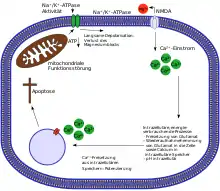Excitotoxizität
Excitotoxizität (vom lateinischen excitare = antreiben und griechischen toxikon = Gift), synonym Exzitotoxizität, bezeichnet in den Neurowissenschaften den Tod einer Nervenzelle durch andauernde Reizüberflutung.

Eigenschaften
Durch eine Überaktivierung von Glutamatrezeptoren (insbesondere der AMPA-Rezeptor und der NMDA-Rezeptor) durch Glutamat oder andere Agonisten (insbesondere Kainsäure und NMDA[1]) kann die intrazelluläre Calciumkonzentration so stark ansteigen, dass eine Apoptose in den Nervenzellen ausgelöst wird.[2] Als Calcium-abhängige Proteine werden manche Phospholipasen, Endonukleasen und Proteasen (wie Calpain) aktiviert. Bei Ausbreitung einer Exzitotoxizität im Gewebe können größere Hirngebiete geschädigt werden und absterben. Die Excitotoxizität kann durch eine Ausschüttung von TNF-α im Zuge einer parallel laufenden Immunreaktion verstärkt werden.[3]
Excitotoxizität spielt eine Rolle bei Rückenmarksverletzungen, Schädel-Hirn-Traumata,[4] Schlaganfall,[1][5] Vergiftungen mit manchen Neurotoxinen sowie bei neurodegenerativen Erkrankungen des Zentralnervensystems (ZNS) wie z. B. multiple Sklerose, Alzheimerkrankheit, Amyotrophe Lateralsklerose (ALS),[6] Parkinsonkrankheit,[7] Alkoholismus, Huntington-Krankheit.[8][9] Auch bei der Hypoglykämie und dem Status epilepticus wurde eine erhöhte Glutamatkonzentration rund um die Neuronen festgestellt.
Das Strukturanalogon des Glutamats, β-Methylamino-L-alanin (BMAA), ist ein cyanobakterielles Neurotoxin und ein Agonist des NMDA-Rezeptors, welches vermutlich den ALS/Parkinsonism-dementia complex of Guam auslöst.[10] Die Wirkung des BMAA kann durch den Antagonisten MK801 gehemmt werden.[11]
Einzelnachweise
- K. Szydlowska, M. Tymianski: Calcium, ischemia and excitotoxicity. In: Cell calcium. Band 47, Nummer 2, Februar 2010, S. 122–129, ISSN 1532-1991. doi:10.1016/j.ceca.2010.01.003. PMID 20167368.
- J. Puyal, V. Ginet, P. G. Clarke: Multiple interacting cell death mechanisms in the mediation of excitotoxicity and ischemic brain damage: a challenge for neuroprotection. In: Progress in neurobiology. Band 105, Juni 2013, S. 24–48, ISSN 1873-5118. doi:10.1016/j.pneurobio.2013.03.002. PMID 23567504.
- G. Olmos, J. Lladó: Tumor necrosis factor alpha: a link between neuroinflammation and excitotoxicity. In: Mediators of inflammation. Band 2014, 2014, S. 861231, ISSN 1466-1861. doi:10.1155/2014/861231. PMID 24966471. PMC 4055424 (freier Volltext).
- M. Jia, S. A. Njapo, V. Rastogi, V. S. Hedna: Taming glutamate excitotoxicity: strategic pathway modulation for neuroprotection. In: CNS drugs. Band 29, Nummer 2, Februar 2015, S. 153–162, doi:10.1007/s40263-015-0225-3, PMID 25633850.
- H. Prentice, J. P. Modi, J. Y. Wu: Mechanisms of Neuronal Protection against Excitotoxicity, Endoplasmic Reticulum Stress, and Mitochondrial Dysfunction in Stroke and Neurodegenerative Diseases. In: Oxidative medicine and cellular longevity. Band 2015, 2015, S. 964518, doi:10.1155/2015/964518, PMID 26576229, PMC 4630664 (freier Volltext).
- A. E. King, A. Woodhouse, M. T. Kirkcaldie, J. C. Vickers: Excitotoxicity in ALS: Overstimulation, or overreaction? In: Experimental neurology. Band 275 Pt 1, Januar 2016, S. 162–171, doi:10.1016/j.expneurol.2015.09.019, PMID 26584004.
- G. Ambrosi, S. Cerri, F. Blandini: A further update on the role of excitotoxicity in the pathogenesis of Parkinson's disease. In: Journal of neural transmission (Vienna, Austria : 1996). Band 121, Nummer 8, August 2014, S. 849–859, doi:10.1007/s00702-013-1149-z, PMID 24380931.
- A. Mehta, M. Prabhakar, P. Kumar, R. Deshmukh, P. L. Sharma: Excitotoxicity: bridge to various triggers in neurodegenerative disorders. In: European journal of pharmacology. Band 698, Nummer 1–3, Januar 2013, S. 6–18, ISSN 1879-0712. doi:10.1016/j.ejphar.2012.10.032. PMID 23123057.
- M. D. Sepers, L. A. Raymond: Mechanisms of synaptic dysfunction and excitotoxicity in Huntington's disease. In: Drug discovery today. Band 19, Nummer 7, Juli 2014, S. 990–996, doi:10.1016/j.drudis.2014.02.006, PMID 24603212.
- K. J. Vyas, J. H. Weiss: BMAA–an unusual cyanobacterial neurotoxin. In: Amyotrophic lateral sclerosis : official publication of the World Federation of Neurology Research Group on Motor Neuron Diseases. Band 10 Suppl 2, 2009, S. 50–55, doi:10.3109/17482960903268742, PMID 19929732.
- Chiu, AS; et al.: Excitotoxic potential of the cyanotoxin β-methyl-amino-l-alanine (BMAA) in primary human neurons. In: Toxicon (2012), Band 60, Ausgabe 6, S. 1159–1165. doi:10.1016/j.toxicon.2012.07.169.